University Assignment: Taxation Law of Australia - LAWS20060, Term 1
VerifiedAdded on 2023/01/10
|17
|4112
|54
Homework Assignment
AI Summary
This document presents a comprehensive solution to an individual assignment on the Taxation Law of Australia (LAWS20060), likely for a university course in Term 1, 2019. The assignment explores various aspects of Australian taxation, addressing key concepts and provisions. The solution includes detailed answers to several questions, covering topics such as depreciation methods, tax offsets, the top tax rates, capital gains tax exemptions, and the formula for income tax calculation. It also delves into specific scenarios involving allowable deductions, including interest on loans, work-related expenses, and the non-deductibility of child care expenses. Furthermore, the assignment examines capital gains tax events, including CGT event F2 and B1, and the application of main residential exemptions. The solution also includes a discussion of capital losses and the taxability of prize winnings and other income sources. The solution references relevant legislation, case laws, and tax rulings to support its arguments, demonstrating a thorough understanding of the subject matter.
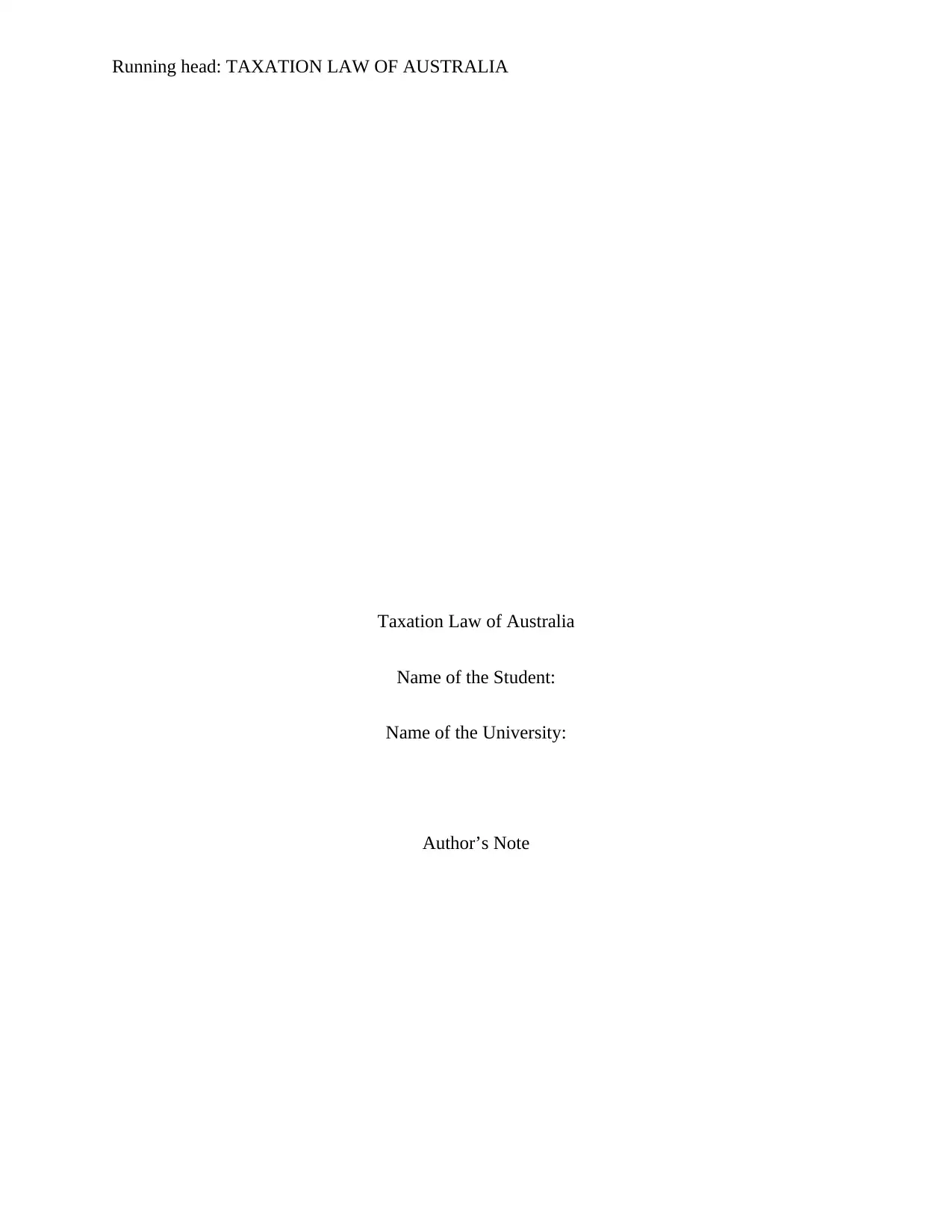
Running head: TAXATION LAW OF AUSTRALIA
Taxation Law of Australia
Name of the Student:
Name of the University:
Author’s Note
Taxation Law of Australia
Name of the Student:
Name of the University:
Author’s Note
Paraphrase This Document
Need a fresh take? Get an instant paraphrase of this document with our AI Paraphraser
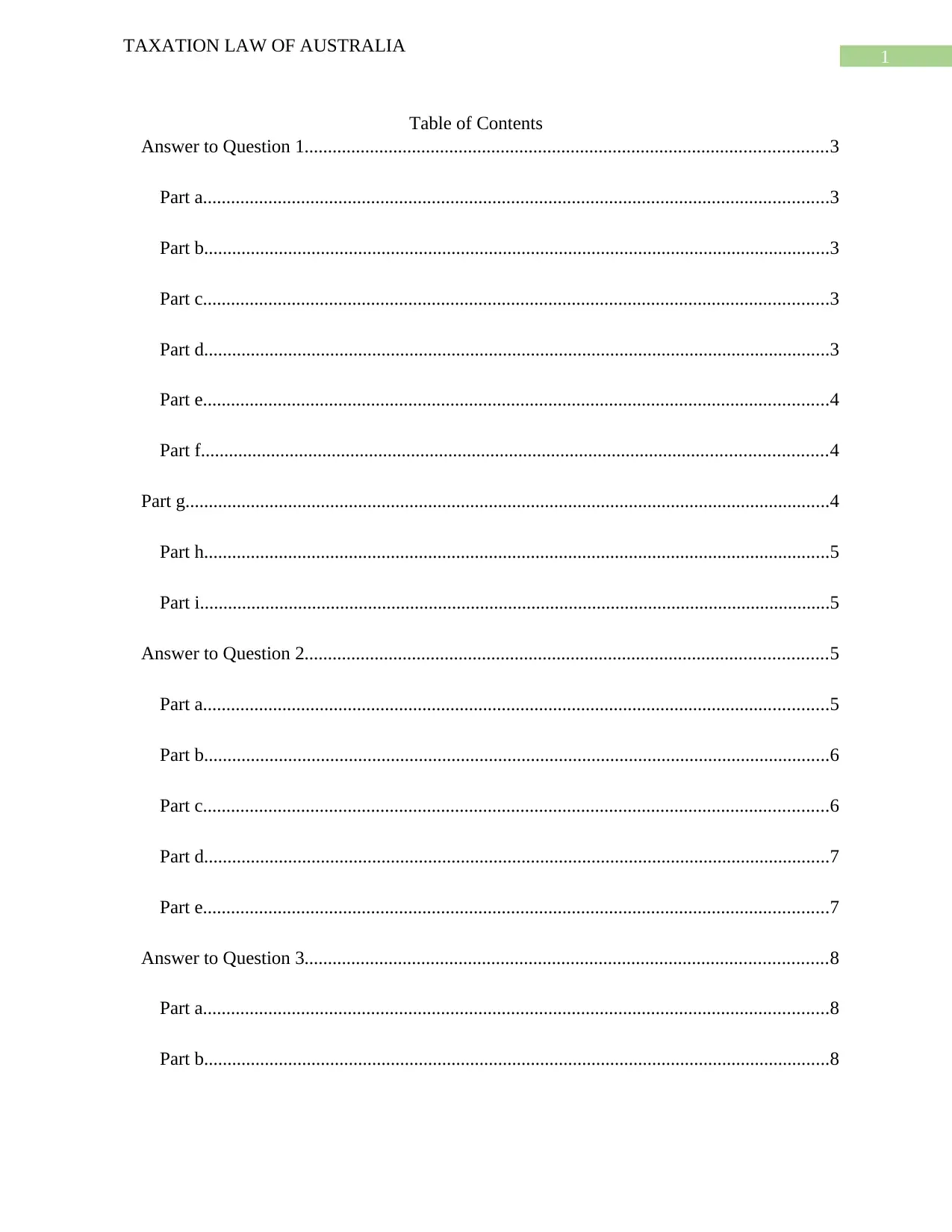
1
TAXATION LAW OF AUSTRALIA
Table of Contents
Answer to Question 1................................................................................................................3
Part a......................................................................................................................................3
Part b......................................................................................................................................3
Part c......................................................................................................................................3
Part d......................................................................................................................................3
Part e......................................................................................................................................4
Part f......................................................................................................................................4
Part g..........................................................................................................................................4
Part h......................................................................................................................................5
Part i.......................................................................................................................................5
Answer to Question 2................................................................................................................5
Part a......................................................................................................................................5
Part b......................................................................................................................................6
Part c......................................................................................................................................6
Part d......................................................................................................................................7
Part e......................................................................................................................................7
Answer to Question 3................................................................................................................8
Part a......................................................................................................................................8
Part b......................................................................................................................................8
TAXATION LAW OF AUSTRALIA
Table of Contents
Answer to Question 1................................................................................................................3
Part a......................................................................................................................................3
Part b......................................................................................................................................3
Part c......................................................................................................................................3
Part d......................................................................................................................................3
Part e......................................................................................................................................4
Part f......................................................................................................................................4
Part g..........................................................................................................................................4
Part h......................................................................................................................................5
Part i.......................................................................................................................................5
Answer to Question 2................................................................................................................5
Part a......................................................................................................................................5
Part b......................................................................................................................................6
Part c......................................................................................................................................6
Part d......................................................................................................................................7
Part e......................................................................................................................................7
Answer to Question 3................................................................................................................8
Part a......................................................................................................................................8
Part b......................................................................................................................................8
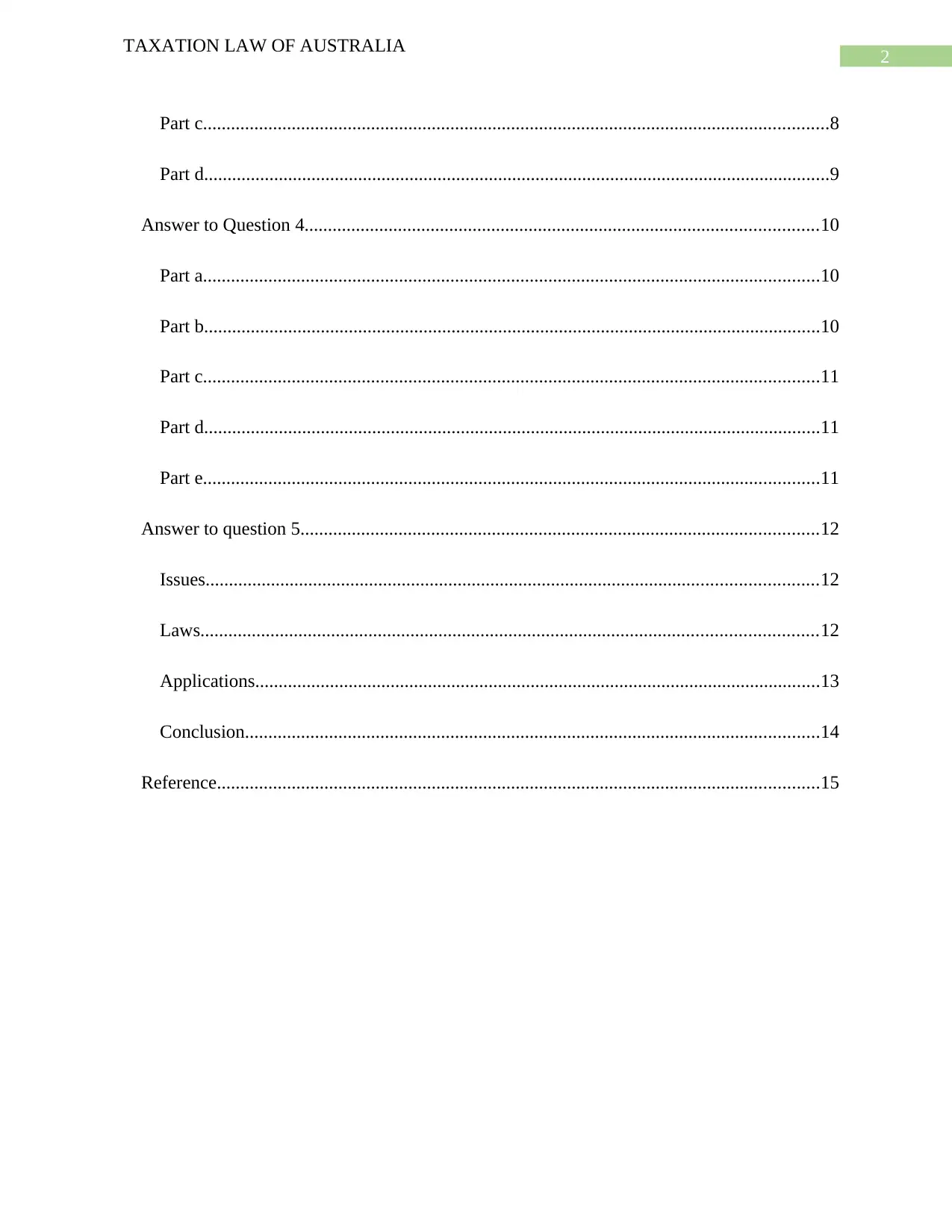
2
TAXATION LAW OF AUSTRALIA
Part c......................................................................................................................................8
Part d......................................................................................................................................9
Answer to Question 4..............................................................................................................10
Part a....................................................................................................................................10
Part b....................................................................................................................................10
Part c....................................................................................................................................11
Part d....................................................................................................................................11
Part e....................................................................................................................................11
Answer to question 5...............................................................................................................12
Issues...................................................................................................................................12
Laws....................................................................................................................................12
Applications.........................................................................................................................13
Conclusion...........................................................................................................................14
Reference.................................................................................................................................15
TAXATION LAW OF AUSTRALIA
Part c......................................................................................................................................8
Part d......................................................................................................................................9
Answer to Question 4..............................................................................................................10
Part a....................................................................................................................................10
Part b....................................................................................................................................10
Part c....................................................................................................................................11
Part d....................................................................................................................................11
Part e....................................................................................................................................11
Answer to question 5...............................................................................................................12
Issues...................................................................................................................................12
Laws....................................................................................................................................12
Applications.........................................................................................................................13
Conclusion...........................................................................................................................14
Reference.................................................................................................................................15
⊘ This is a preview!⊘
Do you want full access?
Subscribe today to unlock all pages.

Trusted by 1+ million students worldwide
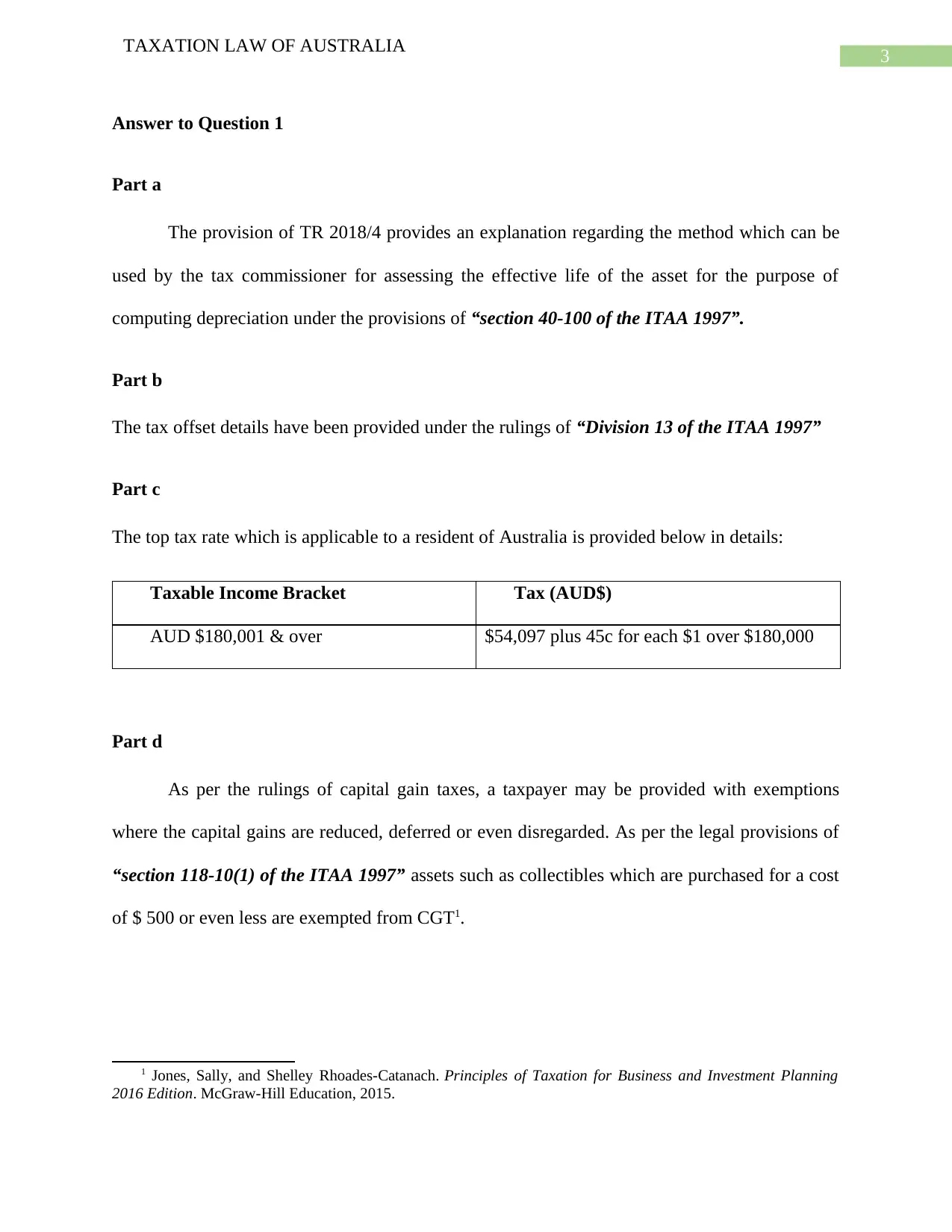
3
TAXATION LAW OF AUSTRALIA
Answer to Question 1
Part a
The provision of TR 2018/4 provides an explanation regarding the method which can be
used by the tax commissioner for assessing the effective life of the asset for the purpose of
computing depreciation under the provisions of “section 40-100 of the ITAA 1997”.
Part b
The tax offset details have been provided under the rulings of “Division 13 of the ITAA 1997”
Part c
The top tax rate which is applicable to a resident of Australia is provided below in details:
Taxable Income Bracket Tax (AUD$)
AUD $180,001 & over $54,097 plus 45c for each $1 over $180,000
Part d
As per the rulings of capital gain taxes, a taxpayer may be provided with exemptions
where the capital gains are reduced, deferred or even disregarded. As per the legal provisions of
“section 118-10(1) of the ITAA 1997” assets such as collectibles which are purchased for a cost
of $ 500 or even less are exempted from CGT1.
1 Jones, Sally, and Shelley Rhoades-Catanach. Principles of Taxation for Business and Investment Planning
2016 Edition. McGraw-Hill Education, 2015.
TAXATION LAW OF AUSTRALIA
Answer to Question 1
Part a
The provision of TR 2018/4 provides an explanation regarding the method which can be
used by the tax commissioner for assessing the effective life of the asset for the purpose of
computing depreciation under the provisions of “section 40-100 of the ITAA 1997”.
Part b
The tax offset details have been provided under the rulings of “Division 13 of the ITAA 1997”
Part c
The top tax rate which is applicable to a resident of Australia is provided below in details:
Taxable Income Bracket Tax (AUD$)
AUD $180,001 & over $54,097 plus 45c for each $1 over $180,000
Part d
As per the rulings of capital gain taxes, a taxpayer may be provided with exemptions
where the capital gains are reduced, deferred or even disregarded. As per the legal provisions of
“section 118-10(1) of the ITAA 1997” assets such as collectibles which are purchased for a cost
of $ 500 or even less are exempted from CGT1.
1 Jones, Sally, and Shelley Rhoades-Catanach. Principles of Taxation for Business and Investment Planning
2016 Edition. McGraw-Hill Education, 2015.
Paraphrase This Document
Need a fresh take? Get an instant paraphrase of this document with our AI Paraphraser
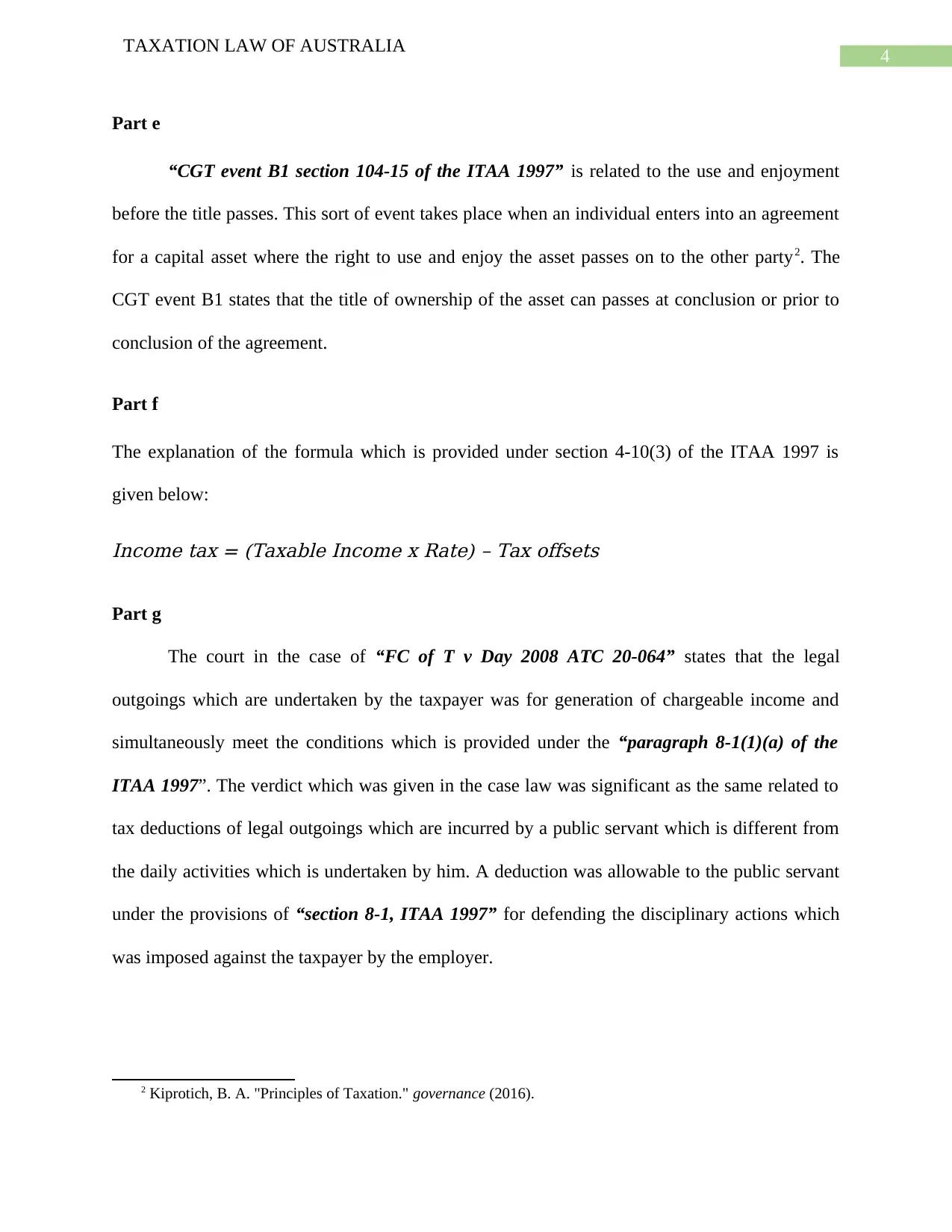
4
TAXATION LAW OF AUSTRALIA
Part e
“CGT event B1 section 104-15 of the ITAA 1997” is related to the use and enjoyment
before the title passes. This sort of event takes place when an individual enters into an agreement
for a capital asset where the right to use and enjoy the asset passes on to the other party2. The
CGT event B1 states that the title of ownership of the asset can passes at conclusion or prior to
conclusion of the agreement.
Part f
The explanation of the formula which is provided under section 4-10(3) of the ITAA 1997 is
given below:
Income tax = (Taxable Income x Rate) – Tax offsets
Part g
The court in the case of “FC of T v Day 2008 ATC 20-064” states that the legal
outgoings which are undertaken by the taxpayer was for generation of chargeable income and
simultaneously meet the conditions which is provided under the “paragraph 8-1(1)(a) of the
ITAA 1997”. The verdict which was given in the case law was significant as the same related to
tax deductions of legal outgoings which are incurred by a public servant which is different from
the daily activities which is undertaken by him. A deduction was allowable to the public servant
under the provisions of “section 8-1, ITAA 1997” for defending the disciplinary actions which
was imposed against the taxpayer by the employer.
2 Kiprotich, B. A. "Principles of Taxation." governance (2016).
TAXATION LAW OF AUSTRALIA
Part e
“CGT event B1 section 104-15 of the ITAA 1997” is related to the use and enjoyment
before the title passes. This sort of event takes place when an individual enters into an agreement
for a capital asset where the right to use and enjoy the asset passes on to the other party2. The
CGT event B1 states that the title of ownership of the asset can passes at conclusion or prior to
conclusion of the agreement.
Part f
The explanation of the formula which is provided under section 4-10(3) of the ITAA 1997 is
given below:
Income tax = (Taxable Income x Rate) – Tax offsets
Part g
The court in the case of “FC of T v Day 2008 ATC 20-064” states that the legal
outgoings which are undertaken by the taxpayer was for generation of chargeable income and
simultaneously meet the conditions which is provided under the “paragraph 8-1(1)(a) of the
ITAA 1997”. The verdict which was given in the case law was significant as the same related to
tax deductions of legal outgoings which are incurred by a public servant which is different from
the daily activities which is undertaken by him. A deduction was allowable to the public servant
under the provisions of “section 8-1, ITAA 1997” for defending the disciplinary actions which
was imposed against the taxpayer by the employer.
2 Kiprotich, B. A. "Principles of Taxation." governance (2016).
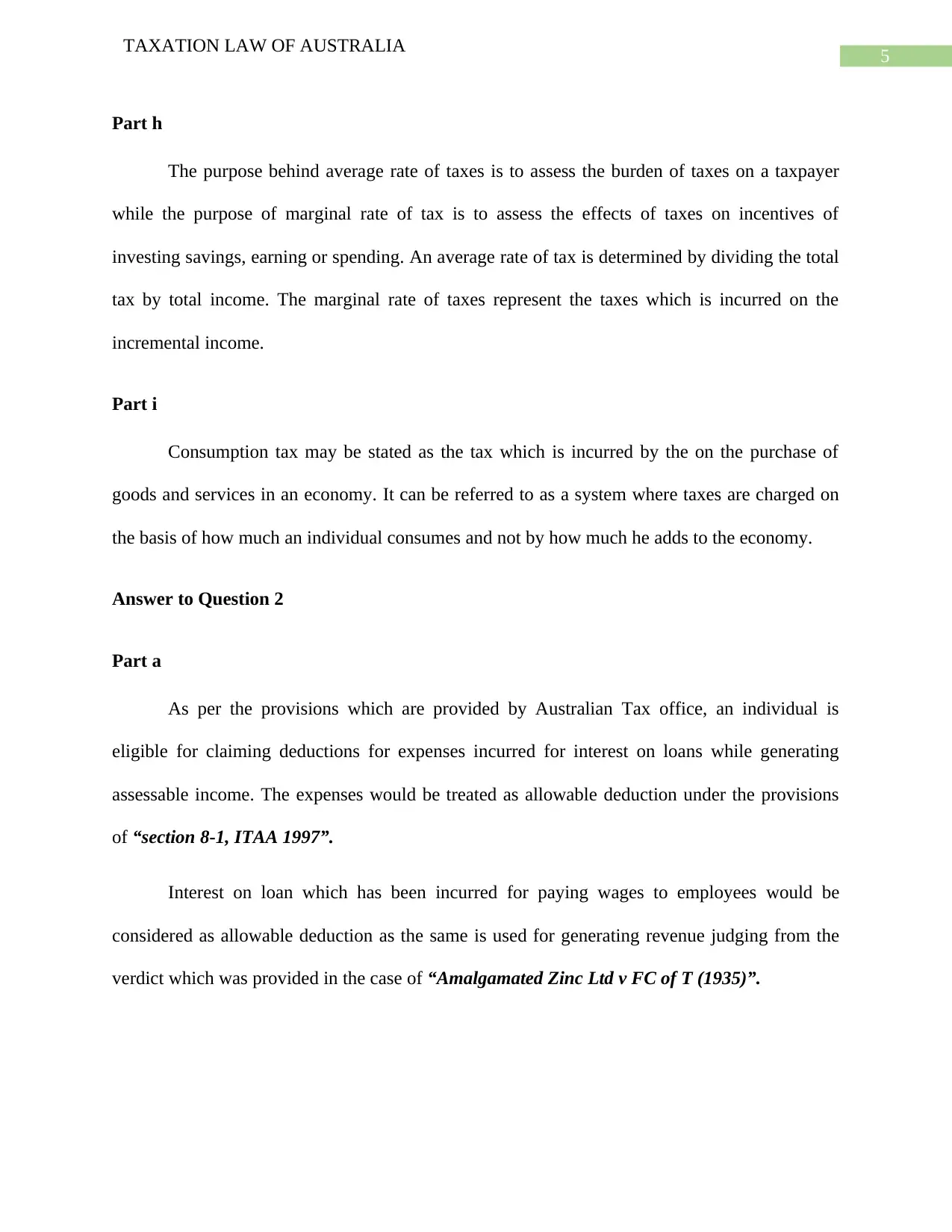
5
TAXATION LAW OF AUSTRALIA
Part h
The purpose behind average rate of taxes is to assess the burden of taxes on a taxpayer
while the purpose of marginal rate of tax is to assess the effects of taxes on incentives of
investing savings, earning or spending. An average rate of tax is determined by dividing the total
tax by total income. The marginal rate of taxes represent the taxes which is incurred on the
incremental income.
Part i
Consumption tax may be stated as the tax which is incurred by the on the purchase of
goods and services in an economy. It can be referred to as a system where taxes are charged on
the basis of how much an individual consumes and not by how much he adds to the economy.
Answer to Question 2
Part a
As per the provisions which are provided by Australian Tax office, an individual is
eligible for claiming deductions for expenses incurred for interest on loans while generating
assessable income. The expenses would be treated as allowable deduction under the provisions
of “section 8-1, ITAA 1997”.
Interest on loan which has been incurred for paying wages to employees would be
considered as allowable deduction as the same is used for generating revenue judging from the
verdict which was provided in the case of “Amalgamated Zinc Ltd v FC of T (1935)”.
TAXATION LAW OF AUSTRALIA
Part h
The purpose behind average rate of taxes is to assess the burden of taxes on a taxpayer
while the purpose of marginal rate of tax is to assess the effects of taxes on incentives of
investing savings, earning or spending. An average rate of tax is determined by dividing the total
tax by total income. The marginal rate of taxes represent the taxes which is incurred on the
incremental income.
Part i
Consumption tax may be stated as the tax which is incurred by the on the purchase of
goods and services in an economy. It can be referred to as a system where taxes are charged on
the basis of how much an individual consumes and not by how much he adds to the economy.
Answer to Question 2
Part a
As per the provisions which are provided by Australian Tax office, an individual is
eligible for claiming deductions for expenses incurred for interest on loans while generating
assessable income. The expenses would be treated as allowable deduction under the provisions
of “section 8-1, ITAA 1997”.
Interest on loan which has been incurred for paying wages to employees would be
considered as allowable deduction as the same is used for generating revenue judging from the
verdict which was provided in the case of “Amalgamated Zinc Ltd v FC of T (1935)”.
⊘ This is a preview!⊘
Do you want full access?
Subscribe today to unlock all pages.

Trusted by 1+ million students worldwide
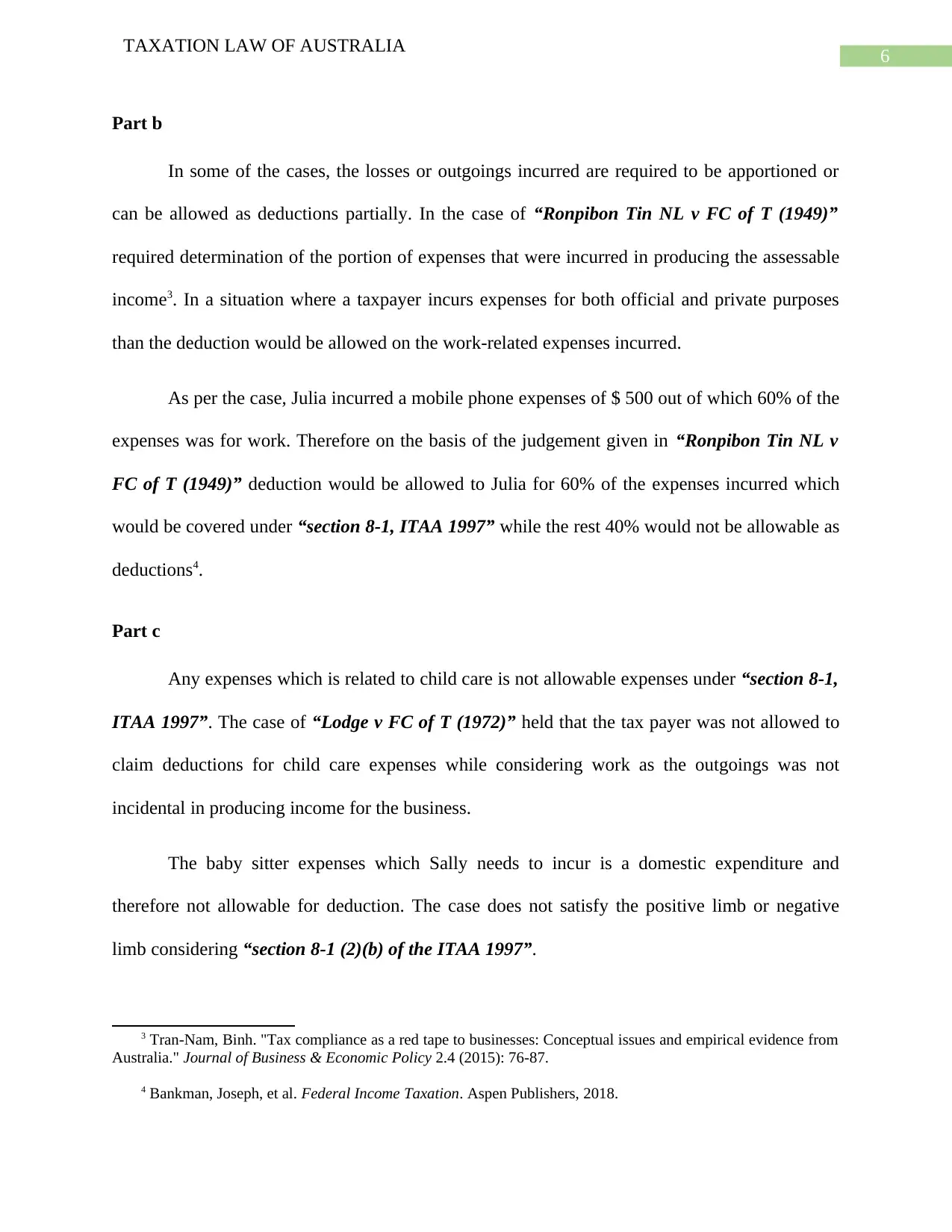
6
TAXATION LAW OF AUSTRALIA
Part b
In some of the cases, the losses or outgoings incurred are required to be apportioned or
can be allowed as deductions partially. In the case of “Ronpibon Tin NL v FC of T (1949)”
required determination of the portion of expenses that were incurred in producing the assessable
income3. In a situation where a taxpayer incurs expenses for both official and private purposes
than the deduction would be allowed on the work-related expenses incurred.
As per the case, Julia incurred a mobile phone expenses of $ 500 out of which 60% of the
expenses was for work. Therefore on the basis of the judgement given in “Ronpibon Tin NL v
FC of T (1949)” deduction would be allowed to Julia for 60% of the expenses incurred which
would be covered under “section 8-1, ITAA 1997” while the rest 40% would not be allowable as
deductions4.
Part c
Any expenses which is related to child care is not allowable expenses under “section 8-1,
ITAA 1997”. The case of “Lodge v FC of T (1972)” held that the tax payer was not allowed to
claim deductions for child care expenses while considering work as the outgoings was not
incidental in producing income for the business.
The baby sitter expenses which Sally needs to incur is a domestic expenditure and
therefore not allowable for deduction. The case does not satisfy the positive limb or negative
limb considering “section 8-1 (2)(b) of the ITAA 1997”.
3 Tran-Nam, Binh. "Tax compliance as a red tape to businesses: Conceptual issues and empirical evidence from
Australia." Journal of Business & Economic Policy 2.4 (2015): 76-87.
4 Bankman, Joseph, et al. Federal Income Taxation. Aspen Publishers, 2018.
TAXATION LAW OF AUSTRALIA
Part b
In some of the cases, the losses or outgoings incurred are required to be apportioned or
can be allowed as deductions partially. In the case of “Ronpibon Tin NL v FC of T (1949)”
required determination of the portion of expenses that were incurred in producing the assessable
income3. In a situation where a taxpayer incurs expenses for both official and private purposes
than the deduction would be allowed on the work-related expenses incurred.
As per the case, Julia incurred a mobile phone expenses of $ 500 out of which 60% of the
expenses was for work. Therefore on the basis of the judgement given in “Ronpibon Tin NL v
FC of T (1949)” deduction would be allowed to Julia for 60% of the expenses incurred which
would be covered under “section 8-1, ITAA 1997” while the rest 40% would not be allowable as
deductions4.
Part c
Any expenses which is related to child care is not allowable expenses under “section 8-1,
ITAA 1997”. The case of “Lodge v FC of T (1972)” held that the tax payer was not allowed to
claim deductions for child care expenses while considering work as the outgoings was not
incidental in producing income for the business.
The baby sitter expenses which Sally needs to incur is a domestic expenditure and
therefore not allowable for deduction. The case does not satisfy the positive limb or negative
limb considering “section 8-1 (2)(b) of the ITAA 1997”.
3 Tran-Nam, Binh. "Tax compliance as a red tape to businesses: Conceptual issues and empirical evidence from
Australia." Journal of Business & Economic Policy 2.4 (2015): 76-87.
4 Bankman, Joseph, et al. Federal Income Taxation. Aspen Publishers, 2018.
Paraphrase This Document
Need a fresh take? Get an instant paraphrase of this document with our AI Paraphraser
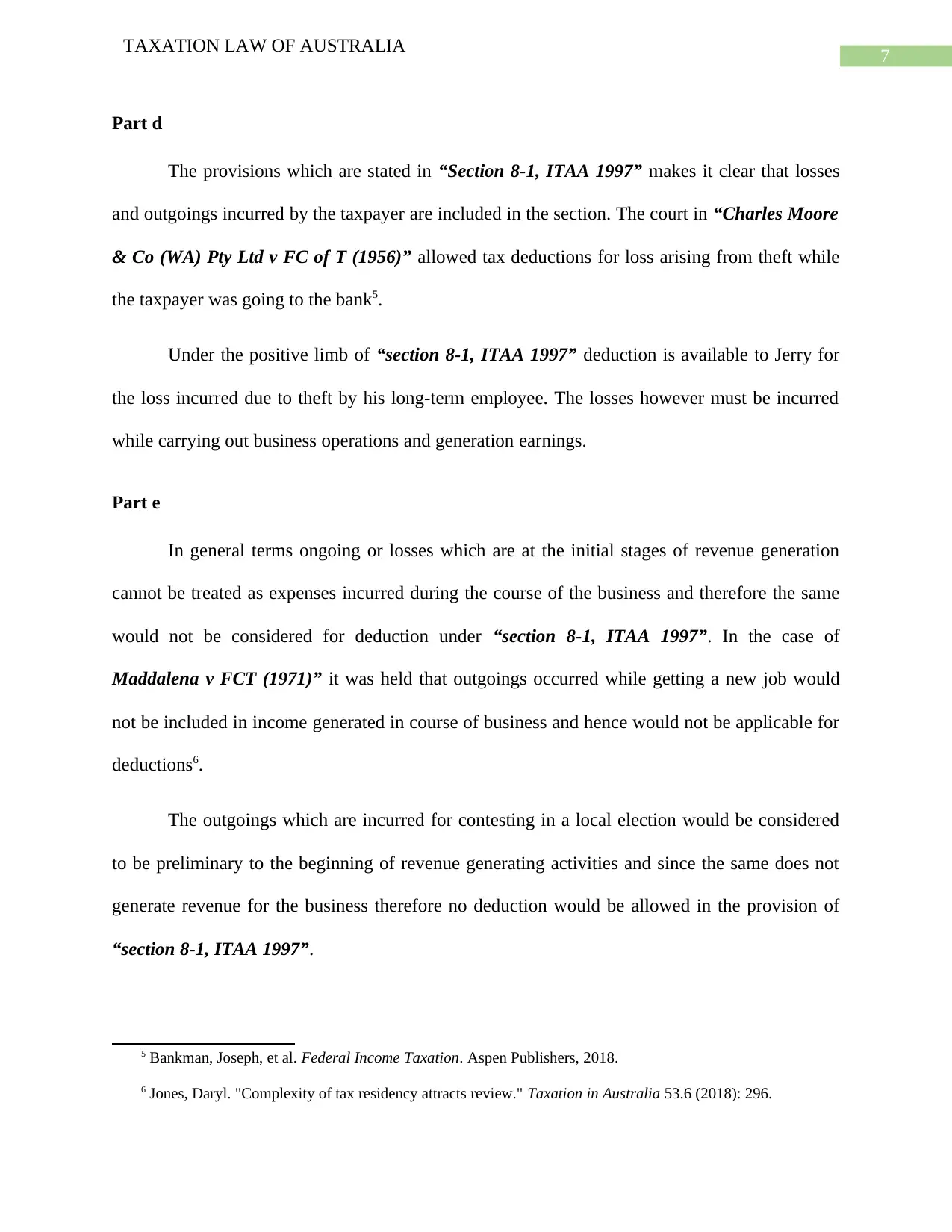
7
TAXATION LAW OF AUSTRALIA
Part d
The provisions which are stated in “Section 8-1, ITAA 1997” makes it clear that losses
and outgoings incurred by the taxpayer are included in the section. The court in “Charles Moore
& Co (WA) Pty Ltd v FC of T (1956)” allowed tax deductions for loss arising from theft while
the taxpayer was going to the bank5.
Under the positive limb of “section 8-1, ITAA 1997” deduction is available to Jerry for
the loss incurred due to theft by his long-term employee. The losses however must be incurred
while carrying out business operations and generation earnings.
Part e
In general terms ongoing or losses which are at the initial stages of revenue generation
cannot be treated as expenses incurred during the course of the business and therefore the same
would not be considered for deduction under “section 8-1, ITAA 1997”. In the case of
Maddalena v FCT (1971)” it was held that outgoings occurred while getting a new job would
not be included in income generated in course of business and hence would not be applicable for
deductions6.
The outgoings which are incurred for contesting in a local election would be considered
to be preliminary to the beginning of revenue generating activities and since the same does not
generate revenue for the business therefore no deduction would be allowed in the provision of
“section 8-1, ITAA 1997”.
5 Bankman, Joseph, et al. Federal Income Taxation. Aspen Publishers, 2018.
6 Jones, Daryl. "Complexity of tax residency attracts review." Taxation in Australia 53.6 (2018): 296.
TAXATION LAW OF AUSTRALIA
Part d
The provisions which are stated in “Section 8-1, ITAA 1997” makes it clear that losses
and outgoings incurred by the taxpayer are included in the section. The court in “Charles Moore
& Co (WA) Pty Ltd v FC of T (1956)” allowed tax deductions for loss arising from theft while
the taxpayer was going to the bank5.
Under the positive limb of “section 8-1, ITAA 1997” deduction is available to Jerry for
the loss incurred due to theft by his long-term employee. The losses however must be incurred
while carrying out business operations and generation earnings.
Part e
In general terms ongoing or losses which are at the initial stages of revenue generation
cannot be treated as expenses incurred during the course of the business and therefore the same
would not be considered for deduction under “section 8-1, ITAA 1997”. In the case of
Maddalena v FCT (1971)” it was held that outgoings occurred while getting a new job would
not be included in income generated in course of business and hence would not be applicable for
deductions6.
The outgoings which are incurred for contesting in a local election would be considered
to be preliminary to the beginning of revenue generating activities and since the same does not
generate revenue for the business therefore no deduction would be allowed in the provision of
“section 8-1, ITAA 1997”.
5 Bankman, Joseph, et al. Federal Income Taxation. Aspen Publishers, 2018.
6 Jones, Daryl. "Complexity of tax residency attracts review." Taxation in Australia 53.6 (2018): 296.
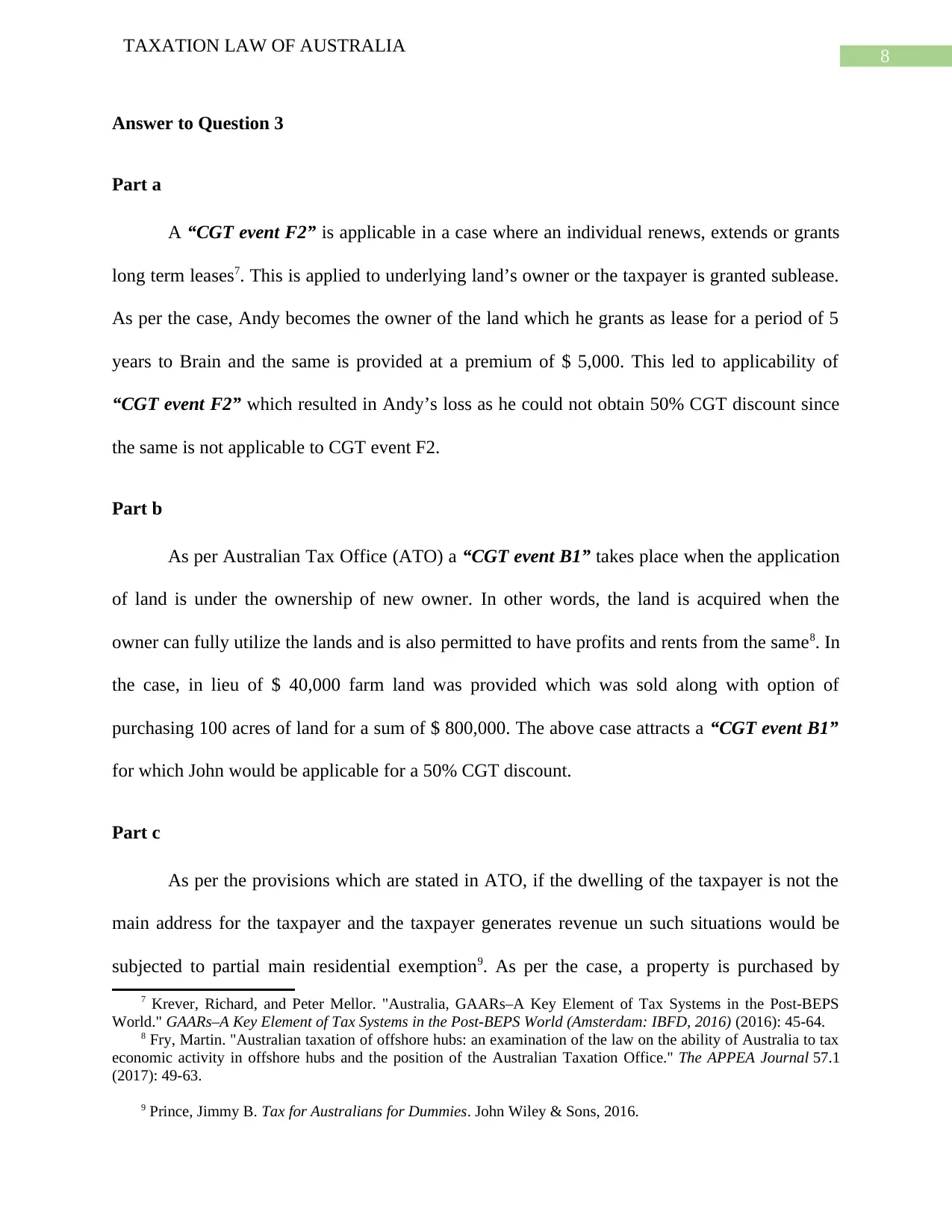
8
TAXATION LAW OF AUSTRALIA
Answer to Question 3
Part a
A “CGT event F2” is applicable in a case where an individual renews, extends or grants
long term leases7. This is applied to underlying land’s owner or the taxpayer is granted sublease.
As per the case, Andy becomes the owner of the land which he grants as lease for a period of 5
years to Brain and the same is provided at a premium of $ 5,000. This led to applicability of
“CGT event F2” which resulted in Andy’s loss as he could not obtain 50% CGT discount since
the same is not applicable to CGT event F2.
Part b
As per Australian Tax Office (ATO) a “CGT event B1” takes place when the application
of land is under the ownership of new owner. In other words, the land is acquired when the
owner can fully utilize the lands and is also permitted to have profits and rents from the same8. In
the case, in lieu of $ 40,000 farm land was provided which was sold along with option of
purchasing 100 acres of land for a sum of $ 800,000. The above case attracts a “CGT event B1”
for which John would be applicable for a 50% CGT discount.
Part c
As per the provisions which are stated in ATO, if the dwelling of the taxpayer is not the
main address for the taxpayer and the taxpayer generates revenue un such situations would be
subjected to partial main residential exemption9. As per the case, a property is purchased by
7 Krever, Richard, and Peter Mellor. "Australia, GAARs–A Key Element of Tax Systems in the Post-BEPS
World." GAARs–A Key Element of Tax Systems in the Post-BEPS World (Amsterdam: IBFD, 2016) (2016): 45-64.
8 Fry, Martin. "Australian taxation of offshore hubs: an examination of the law on the ability of Australia to tax
economic activity in offshore hubs and the position of the Australian Taxation Office." The APPEA Journal 57.1
(2017): 49-63.
9 Prince, Jimmy B. Tax for Australians for Dummies. John Wiley & Sons, 2016.
TAXATION LAW OF AUSTRALIA
Answer to Question 3
Part a
A “CGT event F2” is applicable in a case where an individual renews, extends or grants
long term leases7. This is applied to underlying land’s owner or the taxpayer is granted sublease.
As per the case, Andy becomes the owner of the land which he grants as lease for a period of 5
years to Brain and the same is provided at a premium of $ 5,000. This led to applicability of
“CGT event F2” which resulted in Andy’s loss as he could not obtain 50% CGT discount since
the same is not applicable to CGT event F2.
Part b
As per Australian Tax Office (ATO) a “CGT event B1” takes place when the application
of land is under the ownership of new owner. In other words, the land is acquired when the
owner can fully utilize the lands and is also permitted to have profits and rents from the same8. In
the case, in lieu of $ 40,000 farm land was provided which was sold along with option of
purchasing 100 acres of land for a sum of $ 800,000. The above case attracts a “CGT event B1”
for which John would be applicable for a 50% CGT discount.
Part c
As per the provisions which are stated in ATO, if the dwelling of the taxpayer is not the
main address for the taxpayer and the taxpayer generates revenue un such situations would be
subjected to partial main residential exemption9. As per the case, a property is purchased by
7 Krever, Richard, and Peter Mellor. "Australia, GAARs–A Key Element of Tax Systems in the Post-BEPS
World." GAARs–A Key Element of Tax Systems in the Post-BEPS World (Amsterdam: IBFD, 2016) (2016): 45-64.
8 Fry, Martin. "Australian taxation of offshore hubs: an examination of the law on the ability of Australia to tax
economic activity in offshore hubs and the position of the Australian Taxation Office." The APPEA Journal 57.1
(2017): 49-63.
9 Prince, Jimmy B. Tax for Australians for Dummies. John Wiley & Sons, 2016.
⊘ This is a preview!⊘
Do you want full access?
Subscribe today to unlock all pages.

Trusted by 1+ million students worldwide
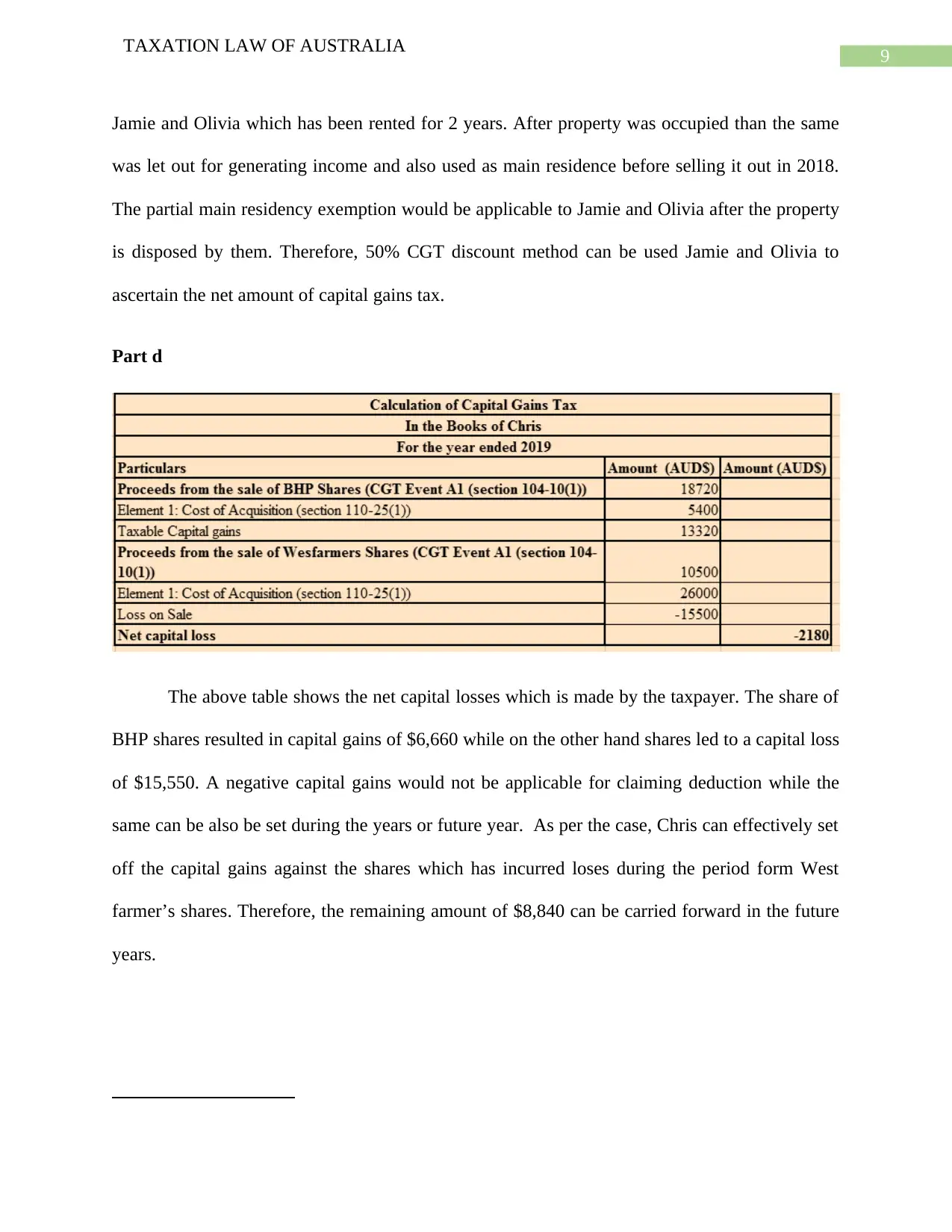
9
TAXATION LAW OF AUSTRALIA
Jamie and Olivia which has been rented for 2 years. After property was occupied than the same
was let out for generating income and also used as main residence before selling it out in 2018.
The partial main residency exemption would be applicable to Jamie and Olivia after the property
is disposed by them. Therefore, 50% CGT discount method can be used Jamie and Olivia to
ascertain the net amount of capital gains tax.
Part d
The above table shows the net capital losses which is made by the taxpayer. The share of
BHP shares resulted in capital gains of $6,660 while on the other hand shares led to a capital loss
of $15,550. A negative capital gains would not be applicable for claiming deduction while the
same can be also be set during the years or future year. As per the case, Chris can effectively set
off the capital gains against the shares which has incurred loses during the period form West
farmer’s shares. Therefore, the remaining amount of $8,840 can be carried forward in the future
years.
TAXATION LAW OF AUSTRALIA
Jamie and Olivia which has been rented for 2 years. After property was occupied than the same
was let out for generating income and also used as main residence before selling it out in 2018.
The partial main residency exemption would be applicable to Jamie and Olivia after the property
is disposed by them. Therefore, 50% CGT discount method can be used Jamie and Olivia to
ascertain the net amount of capital gains tax.
Part d
The above table shows the net capital losses which is made by the taxpayer. The share of
BHP shares resulted in capital gains of $6,660 while on the other hand shares led to a capital loss
of $15,550. A negative capital gains would not be applicable for claiming deduction while the
same can be also be set during the years or future year. As per the case, Chris can effectively set
off the capital gains against the shares which has incurred loses during the period form West
farmer’s shares. Therefore, the remaining amount of $8,840 can be carried forward in the future
years.
Paraphrase This Document
Need a fresh take? Get an instant paraphrase of this document with our AI Paraphraser
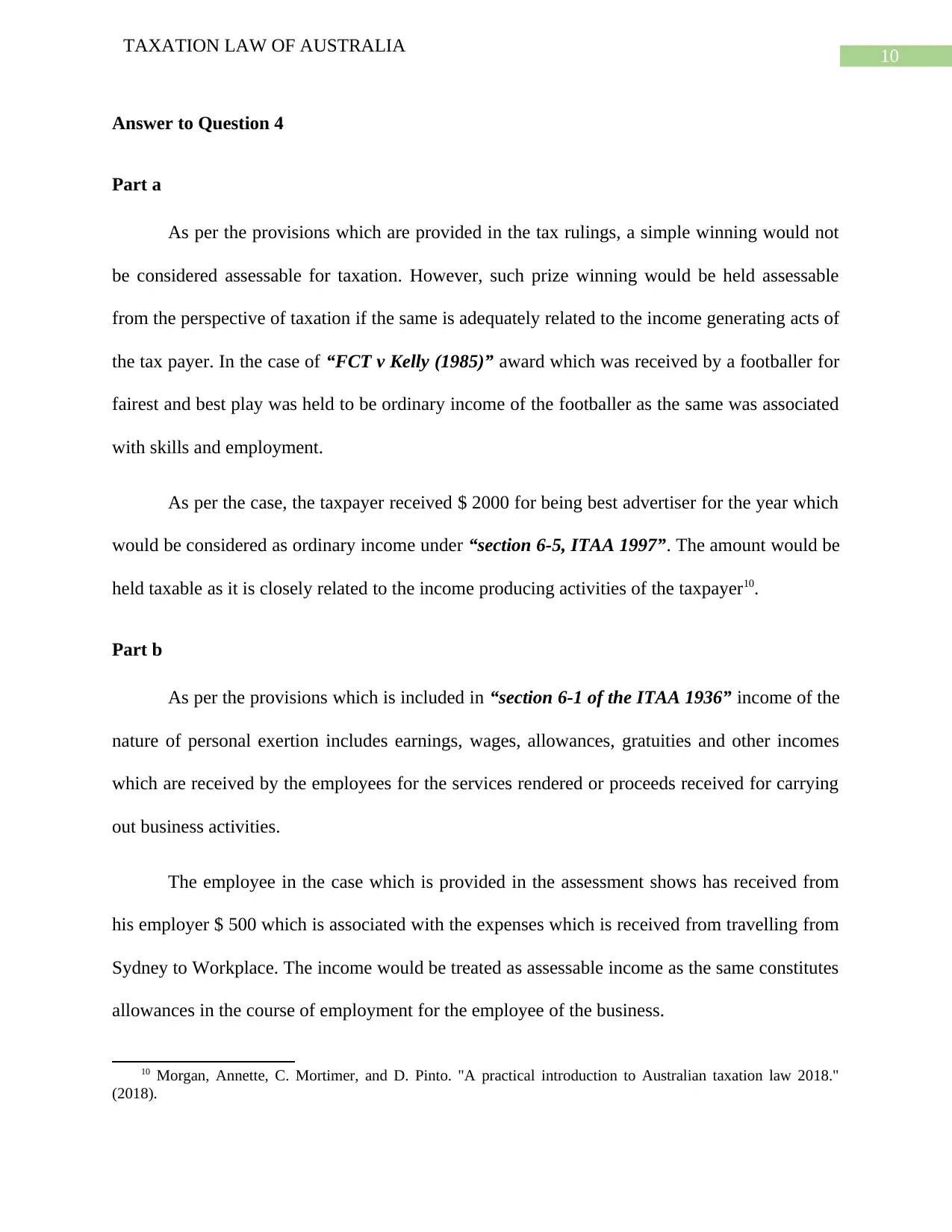
10
TAXATION LAW OF AUSTRALIA
Answer to Question 4
Part a
As per the provisions which are provided in the tax rulings, a simple winning would not
be considered assessable for taxation. However, such prize winning would be held assessable
from the perspective of taxation if the same is adequately related to the income generating acts of
the tax payer. In the case of “FCT v Kelly (1985)” award which was received by a footballer for
fairest and best play was held to be ordinary income of the footballer as the same was associated
with skills and employment.
As per the case, the taxpayer received $ 2000 for being best advertiser for the year which
would be considered as ordinary income under “section 6-5, ITAA 1997”. The amount would be
held taxable as it is closely related to the income producing activities of the taxpayer10.
Part b
As per the provisions which is included in “section 6-1 of the ITAA 1936” income of the
nature of personal exertion includes earnings, wages, allowances, gratuities and other incomes
which are received by the employees for the services rendered or proceeds received for carrying
out business activities.
The employee in the case which is provided in the assessment shows has received from
his employer $ 500 which is associated with the expenses which is received from travelling from
Sydney to Workplace. The income would be treated as assessable income as the same constitutes
allowances in the course of employment for the employee of the business.
10 Morgan, Annette, C. Mortimer, and D. Pinto. "A practical introduction to Australian taxation law 2018."
(2018).
TAXATION LAW OF AUSTRALIA
Answer to Question 4
Part a
As per the provisions which are provided in the tax rulings, a simple winning would not
be considered assessable for taxation. However, such prize winning would be held assessable
from the perspective of taxation if the same is adequately related to the income generating acts of
the tax payer. In the case of “FCT v Kelly (1985)” award which was received by a footballer for
fairest and best play was held to be ordinary income of the footballer as the same was associated
with skills and employment.
As per the case, the taxpayer received $ 2000 for being best advertiser for the year which
would be considered as ordinary income under “section 6-5, ITAA 1997”. The amount would be
held taxable as it is closely related to the income producing activities of the taxpayer10.
Part b
As per the provisions which is included in “section 6-1 of the ITAA 1936” income of the
nature of personal exertion includes earnings, wages, allowances, gratuities and other incomes
which are received by the employees for the services rendered or proceeds received for carrying
out business activities.
The employee in the case which is provided in the assessment shows has received from
his employer $ 500 which is associated with the expenses which is received from travelling from
Sydney to Workplace. The income would be treated as assessable income as the same constitutes
allowances in the course of employment for the employee of the business.
10 Morgan, Annette, C. Mortimer, and D. Pinto. "A practical introduction to Australian taxation law 2018."
(2018).
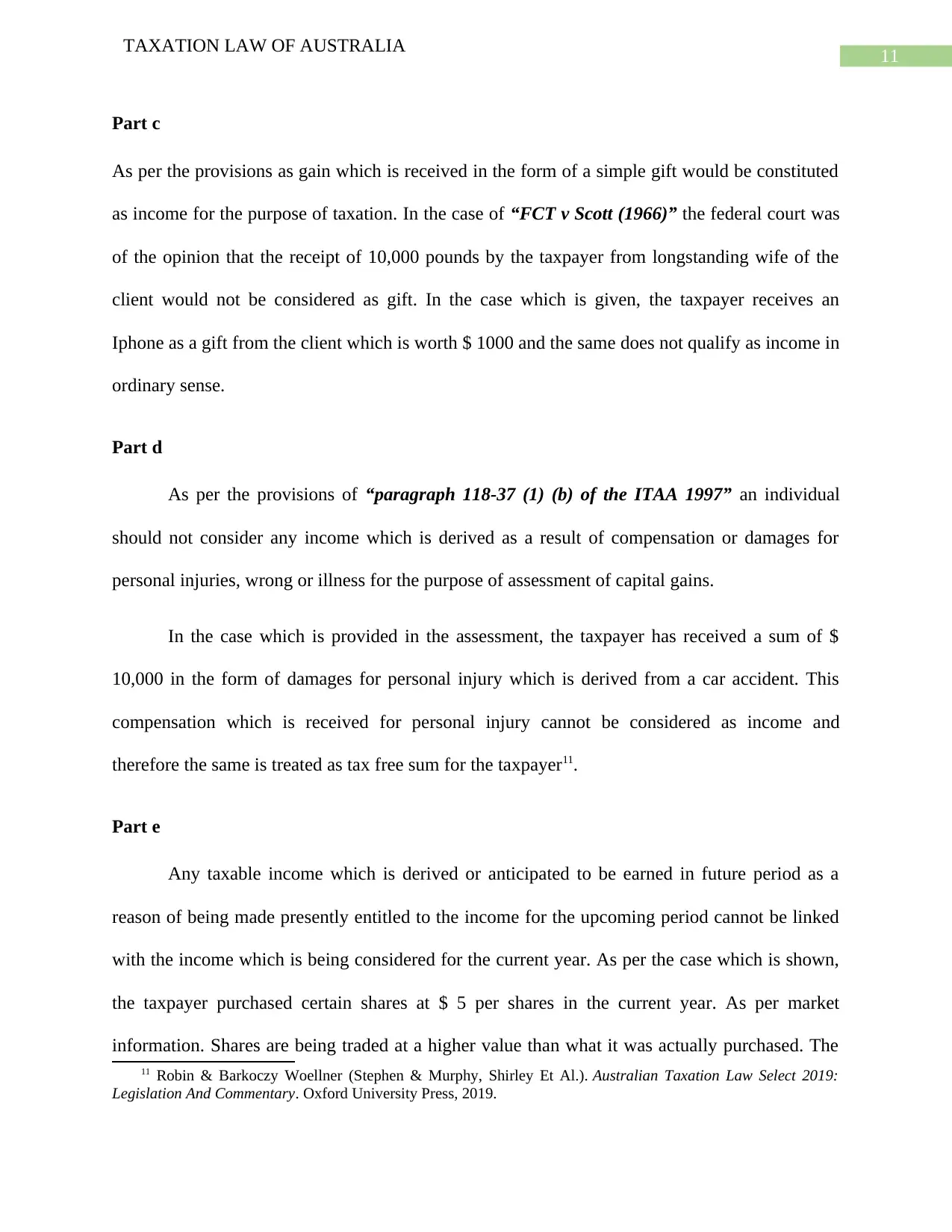
11
TAXATION LAW OF AUSTRALIA
Part c
As per the provisions as gain which is received in the form of a simple gift would be constituted
as income for the purpose of taxation. In the case of “FCT v Scott (1966)” the federal court was
of the opinion that the receipt of 10,000 pounds by the taxpayer from longstanding wife of the
client would not be considered as gift. In the case which is given, the taxpayer receives an
Iphone as a gift from the client which is worth $ 1000 and the same does not qualify as income in
ordinary sense.
Part d
As per the provisions of “paragraph 118-37 (1) (b) of the ITAA 1997” an individual
should not consider any income which is derived as a result of compensation or damages for
personal injuries, wrong or illness for the purpose of assessment of capital gains.
In the case which is provided in the assessment, the taxpayer has received a sum of $
10,000 in the form of damages for personal injury which is derived from a car accident. This
compensation which is received for personal injury cannot be considered as income and
therefore the same is treated as tax free sum for the taxpayer11.
Part e
Any taxable income which is derived or anticipated to be earned in future period as a
reason of being made presently entitled to the income for the upcoming period cannot be linked
with the income which is being considered for the current year. As per the case which is shown,
the taxpayer purchased certain shares at $ 5 per shares in the current year. As per market
information. Shares are being traded at a higher value than what it was actually purchased. The
11 Robin & Barkoczy Woellner (Stephen & Murphy, Shirley Et Al.). Australian Taxation Law Select 2019:
Legislation And Commentary. Oxford University Press, 2019.
TAXATION LAW OF AUSTRALIA
Part c
As per the provisions as gain which is received in the form of a simple gift would be constituted
as income for the purpose of taxation. In the case of “FCT v Scott (1966)” the federal court was
of the opinion that the receipt of 10,000 pounds by the taxpayer from longstanding wife of the
client would not be considered as gift. In the case which is given, the taxpayer receives an
Iphone as a gift from the client which is worth $ 1000 and the same does not qualify as income in
ordinary sense.
Part d
As per the provisions of “paragraph 118-37 (1) (b) of the ITAA 1997” an individual
should not consider any income which is derived as a result of compensation or damages for
personal injuries, wrong or illness for the purpose of assessment of capital gains.
In the case which is provided in the assessment, the taxpayer has received a sum of $
10,000 in the form of damages for personal injury which is derived from a car accident. This
compensation which is received for personal injury cannot be considered as income and
therefore the same is treated as tax free sum for the taxpayer11.
Part e
Any taxable income which is derived or anticipated to be earned in future period as a
reason of being made presently entitled to the income for the upcoming period cannot be linked
with the income which is being considered for the current year. As per the case which is shown,
the taxpayer purchased certain shares at $ 5 per shares in the current year. As per market
information. Shares are being traded at a higher value than what it was actually purchased. The
11 Robin & Barkoczy Woellner (Stephen & Murphy, Shirley Et Al.). Australian Taxation Law Select 2019:
Legislation And Commentary. Oxford University Press, 2019.
⊘ This is a preview!⊘
Do you want full access?
Subscribe today to unlock all pages.

Trusted by 1+ million students worldwide
1 out of 17
Related Documents
Your All-in-One AI-Powered Toolkit for Academic Success.
+13062052269
info@desklib.com
Available 24*7 on WhatsApp / Email
![[object Object]](/_next/static/media/star-bottom.7253800d.svg)
Unlock your academic potential
Copyright © 2020–2025 A2Z Services. All Rights Reserved. Developed and managed by ZUCOL.
![Taxation Law Assignment - LAWS20060, Semester 1, [University Name]](/_next/image/?url=https%3A%2F%2Fdesklib.com%2Fmedia%2Fimages%2Fzu%2F803f7afcdaf14edca4b16cd62f859dfd.jpg&w=256&q=75)




